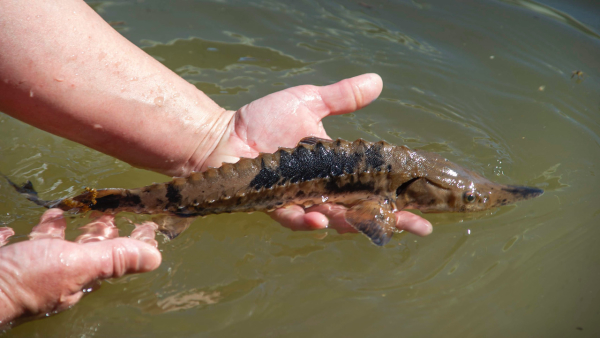
Chattanooga, TN – Wednesday afternoon, under the curious scrutiny of onlookers gathered at the Coolidge Park boat ramp, Chattanooga students and scientists from the Tennessee Aquarium Conservation Institute carefully eased about 90 dinosaurs into the Tennessee River.
At just 15-inches long, the nine-month-old Lake Sturgeon that slipped into the current still have many years of growing before potentially becoming an eight-foot river giant. Even at this early stage, however, these 89 sleek, armor-plated fish embodied a wealth of promise.
“The hard work of the Aquarium and its partners, plus so many others who have joined over the past twenty years, have really changed things for Lake Sturgeon,” says Dr. Anna George, the Aquarium’s vice president of conservation science and education. “This group effort has shown that, together, we can make steps towards our goal of having healthy rivers that are full of life.”
Now back in their ancestral waters, each Lake Sturgeon could live for more than a century. These fish represent the next generation of a species that first appeared alongside dinosaurs during the late Cretaceous Period but whose story almost ended abruptly not from a meteor strike, but our own poor decisions just a few decades ago.
In the 1970s the Lake Sturgeon had all but disappeared from the Tennessee River due to overfishing, poor water quality and man-made alterations to the waterway. By the late 1990s, landmark legislation and responsible water management practices had improved conditions to the point that biologists thought it possible for the river to once again support a population of these ancient fish.
In 1998, with the aim of restoring the Lake Sturgeon to the river, the Aquarium and several partner organizations created the Lake Sturgeon Working Group. Since the formation of that organization, more than 220,000 juvenile Lake Sturgeon raised from eggs collected in the Great Lakes have been reintroduced to the Tennessee and Cumberland river drainages.
Although they’re barely the length of a bowling pin, the baby Lake Sturgeon that entered the river on Wednesday are veritable giants compared to the vast majority of the fish that preceded them, most of which are around six inches long when they are released.
These Sturgeon are so much larger because they were held for longer at the Conservation Institute’s freshwater science center to help biologists better understand the potential effects of using coded wire tags to track their movement after release. Each tiny tag measures a couple of millimeters long and is inserted just below the surface of the fish’s rostrum (snout). When scientists collect tagged fish later during monitoring efforts, they can scan these tags to chart how the fish are moving throughout their range.
However, a Sturgeon’s rostrum also houses a kind of antenna that can detect the unique electric signatures created by the movement of the bottom-dwelling animals upon which it feeds. To ensure the tags weren’t adversely affecting the Sturgeons’ ability to feed, Conservation Institute scientists held back two groups of fish — half were tagged while the others were left untagged. Each group was weighed and then fed a controlled amount of food for 40 days before being measured again.
At the end of the study period, says Aquarium Reintroduction Biologist Meredith Harris, there was no difference in size between the tagged and untagged fish. These results indicate that the tags either aren’t affecting the Sturgeons’ electro-sensing capabilities, or if they are, that the fish are compensating for the interference by relying on their other senses to find prey.
“The odds that the tags would have a profound impact on their survival were very small, but it was still something worth looking at,” Harris says. “We found that they don’t seem to have any impact on their growth rate.”
Now that they’ve finally joined the rest of the reintroduced Sturgeon in the river, these 89 fish served an important role in the protection of their species. These releases offer an opportunity for members of the public to form a meaningful bond with an imperiled native species and further raise awareness of the ongoing effort to restore this ancient fish Harris says.
“People can read a lot about the conservation of animals, and that’s all well and good, but it really brings it home when people can interact with the animals and take a hands-on part in the conservation effort,” she says. “I think that has a great impact on people’s thoughts about conservation and makes it seem more real and more achievable and closer to home.”
For more information about Lake Sturgeon and the Aquarium’s work with this species, visit tnaqua.org/protecting-animals/lake-sturgeon.
Members of the Southeast Lake Sturgeon Working Group include:
• Alabama Department of Conservation and Natural Resources
• Conservation Fisheries Inc.
• Georgia Department of Natural Resources
• Kentucky Department of Fish and Wildlife
• North Carolina Wildlife Resources Commission
• Tennessee Aquarium
• Tennessee Clean Water Network
• Tennessee Technological University
• Tennessee Valley Authority
• Tennessee Wildlife Resources Agency
• University of Tennessee at Knoxville
• U.S. Fish and Wildlife Service
• U.S. Geological Survey
• Wisconsin Department of Natural Resources
• World Wildlife Fund